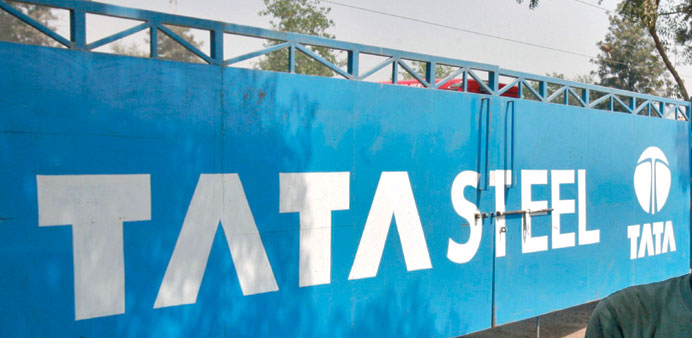Tata Steel, India’s largest steelmaker by market value, swung to a loss in its fourth quarter, hit by weak demand in Europe, its top market and production region.
The company’s January-March net loss was Rs65.29bn ($1.2bn), compared with a Rs43.3bn profit a year earlier. Net sales rose about 1% to Rs341.8bn.
Analysts had expected profit of Rs3.64bn on sales of Rs350.16bn, according Thomson Reuters I/B/E/S.
Earlier this month the company said it would write down goodwill and assets by $1.6bn in the financial year that ended in March, mainly because of weakness in Europe, where demand has fallen by almost a third since 2007.
Lenovo
Lenovo Group’s bold acquisitions in its flagship PC business, a foray into mobile gadgets, and a relatively light debt load are setting it apart from PC rivals as industry shipments take their steepest fall in decades.
Lenovo, a sliver away from unseating Hewlett-Packard Co as the world’s top PC maker by shipments, posted yesterday an estimate-beating 90% rise in quarterly profit, its fastest in seven quarters.
The Chinese PC maker posted net profit of $126.9mn in the quarter ended in March, up from $66.8mn a year earlier, based on Reuters calculations using full-year and nine-month financial data.
That beat expectations of $110mn net profit and was the fastest pace since the first quarter of the 2011/2012 fiscal year, when growth doubled.
With shipments unchanged in the first quarter, Lenovo is outstripping other vendors.
For the full year, Lenovo’s net profit rose by a third to $635.1mn, it said in a statement to the Hong Kong stock exchange, beating an estimate of $618.2mn in a poll of 31 analysts by Thomson Reuters I/B/E/S.
Lenovo has spent heavily over the past few years to strengthen its PC business, with purchases such as Brazilian electronics maker CCE last year, Germany’s Medion in 2011 and IBM’s PC business in 2005.
Its slew of acquisitions has also sparked market talk that it might be interested in IBM Corp’s server business, as well as handset makers Research In Motion Ltd and Nokia Oyj. Lenovo has cash totalling $4.5bn, vastly outweighing debt of $423mn, and giving it the muscle for more buyouts.
“We expect Lenovo to remain acquisitive as it is hungry for growth and so despite high cash balances they will not hike the dividend,” said Jefferies technology analyst Ken Hui.
The Beijing-based company has shed its staid image as the maker of all-business ThinkPads, and now churns out multi-coloured IdeaPad Yoga convertible ultrabooks which have helped build its brand in China and beyond.
Though newer to smartphones than to its core PC business, Lenovo is the No 2 smartphone and media tablet vendor in China, a success it hopes to duplicate in other emerging markets such as Russia and India, where competition from Samsung Electronics Co Ltd, Apple Inc and others is fierce.
“They are in the right niche markets and hitting the right segments at the right price points. But this is not sustainable in the long run unless the mobility business steps up,” said a Hong Kong-based technology banker.
AirAsia
AirAsia, Asia’s largest low-cost carrier by fleet size, said that first-quarter net profit fell 39% year-on-year due to a foreign exchange loss on borrowings.
The airline said in a filing to the Malaysian stock exchange that profit for the three months ending March 31 was 104.79mn ringgit ($34.79mn) compared to 172.44mn ringgit in the same quarter last year.
Revenue for the quarter stood at 1.30bn ringgit, up 11.3% from the same period last year, due mainly to a seven% increase in passengers, the company said in a statement.
“The company has started off the year strongly, driven by an outstanding financial performance last year,” said chief executive officer Aireen Omar.
AirAsia has also set up subsidiary budget carriers in Indonesia, the Philippines, Thailand and Japan.
Thai AirAsia recorded a 24% increase in revenue, while Indonesia AirAsia’s revenue rose 34% in the first quarter year-on-year, it said.
AirAsia Group chief executive officer Tony Fernandes said the company would continue to expand in each of its markets.
“It is important not to be complacent, especially with the new competitive landscape” in Malaysia, said Fernandes, a former music industry executive.
The low-cost carrier has grown from two planes when Fernandes bought the then-struggling airline in 2001 to a total fleet of more than 120 A320s.
The airline, one of the biggest customers for European aircraft maker Airbus, is expecting nearly 360 more aircraft to be delivered up to 2026.
Aireen said AirAsia Malaysia would get six aircraft this year, four fewer than initially planned “to make room for associates to grow”.
Last month, AirAsia announced it has begun recruiting pilots for a no-frills Indian airline joint venture with Tata group planned for later this year.
Toronto-Dominion Bank
Toronto-Dominion Bank reported a 2% increase in quarterly earnings, driven by stronger trading-related revenue and higher income from its US retail banking unit.
The bank, Canada’s second-largest, said on Thursday that it had earned a net C$1.72bn ($1.66bn), or C1.78 a share, in the second quarter ended April 30. That compared with a year-earlier profit of C$1.69bn, or C$1.78 a share.
Excluding items including a C$58mn amortisation charge, earnings were C$1.90 a share. Analysts on average had expected C$1.91, according to Thomson Reuters I/B/E/S.
TD has about 1,100 bank branches in Canada and about 1,300 in the US, where it has a sizeable presence on the Eastern seaboard. It also owns 45% of TD Ameritrade Holding Corp.
Wholesale banking income, which accounts for trading, investment banking and corporate lending, rose 12% to C$220mn, due to stronger trading-related revenue and lower expenses, the bank said.
TD’s US retail banking network produced income of US$392mn, up 9%, on the back of loan and deposit growth.
Income from TD’s Canadian retail bank increased 5% to C$847mn. Lower loan-loss provisions helped make up for sluggish loan growth as Canada’s housing market continued to lose steam.
Logitech
Computer accessories company Logitech International plans to pay an annual dividend every year as new products help it return to sales and profit growth, the company said yesterday.
After announcing an ordinary dividend of 0.21 Swiss francs per share for the year to March 31, Logitech said it would discuss its longer-term goals at its investor event in Zurich later in the day.
It said it expects $2.25bn of sales, operating income of $150mn and a gross margin of about 35% in the year to March 31, 2016.
The company also reiterated its forecast for this financial year, with sales of about $2bn, operating income of $50mn and gross margin of about 34%.
“Logitech will need to come forward with strong arguments to support its growth strategy in order to convince investors that the company will be able to deliver on its targets,” Vontobel analyst Michael Foeth said.
“We further believe that it will take several quarters and proof by numbers to show that the company is on the right path.”
The company, which makes computer peripherals such as mice, keyboards, cameras and speakers, has been struggling to adapt to the rise of touch-screen tablets and smartphones.
It posted a net loss of $228mn for the full year but said its efforts to accelerate growth in mobility products, maximise profitability in PC peripherals and reduce operating expenses should help it to meet its forecasts.
Intermediate Capital
Intermediate Capital Group, a provider of mezzanine financing, said full-year profit fell 25% due to lower realisation of gains from investments and higher provisions for bad loans.
ICG said the lack of available senior debt in the market in the early part of the financial year and the continuing valuation gap between sellers and buyers resulted in low realisations and realised capital gains during the year.
“Since the turn of the calendar year we have seen more liquidity in the market and, should this remain, we expect that this will result in an increase in realisations and exits in the next twelve months,” chief executive Christophe Evain said.
Adjusted profit before tax fell to £148.3mn ($224.6mn) in the year ended March 31, from £198.8mn in the prior year.
Assets under management rose 13% to €12.9bn ($16.61bn) for the year.
Gross provisions increased 69% to £141.1mn, hurt by a higher-than-expected level of provisions in the first half, mainly arising from two large assets.
Ralph Lauren
Ralph Lauren Corp yesterday reported a higher quarterly profit, helped by a jump in sales at its own stores and lower cotton costs.
The fashion company said net revenue, including licensing revenue, in the fourth quarter ended March 31 rose 1.3% to $1.64bn. Ralph Lauren forecast companywide revenues will rise 4% to 7% in the new fiscal year.
At Ralph Lauren’s own stores open at least a year, which generate about half of sales, revenue was up 7%.
Net income rose to $127.2mn, or $1.37 per share, from $94.4mn or 99¢ per share, a year earlier.
Booker Group
Booker Group, Britain’s biggest cash-and-carry wholesaler, reported a 13% rise in full-year profit, helped by demand from small retailers and growing online sales.
Booker, which runs over 170 branches supplying caterers, convenience stores, grocers, restaurants and pubs, has defied the downturn in the UK cash and carry market and managed to grow sales, as Britons increasingly shop at local convenience stores instead of supermarkets.
The company said trading in the first seven weeks of the current financial year was ahead of last year.
The wholesaler, which acquired the struggling UK operations of German retailer Metro — Makro — in May 2012, said it expected the acquisition to help operating profit grow by 10mn pounds in the year ending March 2014.
“We’re expecting, as we go into the second half, Makro will start to become profitable for us,” chief executive Charles Wilson told Reuters.
Booker operated Makro as a separate unit until Britain’s monopoly watchdog cleared the acquisition in April.
Pretax profit rose to £101.4mn ($152.54mn) in the 52 weeks to March 29, from £89.7mn in the comparable year-earlier period.
Revenue rose 3.5% to £4bn.
Analysts on average expected a pretax profit of £96.25mn and revenue of £4.09bn, according to Thomson Reuters I/B/E/S.
The company said sales to caterers, which includes pubs and restaurants, rose 6.2%, while internet sales grew about 11% to £704mn.
The wholesaler raised its final dividend to 2.25 pence per share from 1.95 pence a year earlier.
Electrocomponents
Electrocomponents reported a 19% drop in full-year pretax profit, hurt by weak international demand, particularly in continental Europe.
However, the British electronic parts supplier — whose products range from cell-phone accessories to thermometers — said sales grew 1% in the first seven weeks of the new financial year beginning April 1, led mainly by the company’s business outside the UK.
Headline pretax profit fell to £98.7mn ($148.5mn) in the year ended March 31 from £122.3mn a year earlier.
Revenue declined slightly to 1.24bn pounds.
Hewlett-Packard
Hewlett-Packard raised its 2013 earnings outlook after beating low expectations, as CEO Meg Whitman’s turnaround plan helped to shore up profits and offset shrinking personal computer sales with enterprise computing services.
While fiscal second-quarter profit plummeted 32%, Wall Street had braced for worse. HP shares gained 14% after the company projected full-year earnings per share of $3.50 to $3.60, raising the lower end by 10¢.
Whitman, who took the helm at the world’s largest PC maker over a year ago, is orchestrating a turnaround to recapture some of the Silicon Valley icon’s former strong growth, a process she has said could take years.
Net income fell to $1.08bn, or 55¢ a share, from $1.59bn, or 80¢ a share, a year earlier.
The company earned 87¢ per share on an operating basis during the second quarter on revenue of $27.6bn.
HP had expected earnings of 81¢ a share on revenue of just over $28bn, according to the average estimate of analysts polled by Thomson Reuters I/B/E/S.
“This is another good deposit on the road to our turnaround here,” HP chief financial officer Cathie Lesjak said in an interview. “We are roughly where we want to be in total on the company.”
Enterprise services and printing units are “probably a little bit ahead,” she said, adding that the two businesses helped drive the company’s gross margin improvement during the quarter.
For its fiscal third quarter, it estimated non-GAAP earnings per share of 84 to 87¢, higher than 83¢ expected by Wall Street analysts.
Revenue fell across HP’s main business divisions, with the steepest decline in the personal systems group. Sales from HP’s largest, PC-focused unit dived 20% to $7.58bn.
But that same division recorded a 3.2% operating margin, up from about 2.7% in the previous quarter, as the company focuses on improving profitability.
The printing division had the smallest revenue decline, of 1%, year over year, but the company said it had a “strong operating margin” of 15.8%.
HP generated $3.6bn in cash flow during the quarter and used some of the funds to reduce net debt by $1.8bn to $2.9bn. The company had $13.6bn in gross cash at the end of the quarter.



